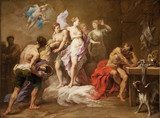Born in Rouen to a family of artists — his father was the architect and sculptor Jean Restout, and his mother, Marie-Madeleine Jouvenet, was a painter — Jean Restout II was in Paris by 1707, a student of his uncle, the famous religious painter Jean Jouvenet. Agréé (accepted) by the Académie Royale in 1717, he became a full member in 1720 with the submission of his mythological painting Alpheus and Arethusa (Rouen, Musée des Beaux-Arts). In the years that followed, Restout became master of a studio with assistants and students; by 1730 he was a professor of drawing at the academy. After the death of his uncle Jouvenet in 1717, Restout became the leading painter of religious subjects, patronized primarily by monastic houses and churches. Following Jouvenet’s example, Restout’s paintings express the ecstatic religious emotion popular during that time, often tempered by a measure of elegance and grace. He also produced secular projects for the Gobelins tapestry manufactory, Versailles, the Hôtel de Soubise, and for Frederick II at the Neues Palais, Potsdam.
Jean Restout
1 records
Include records without images
About this artist
